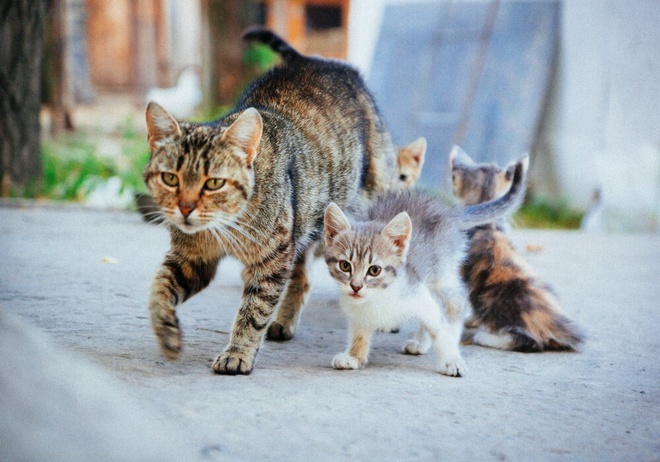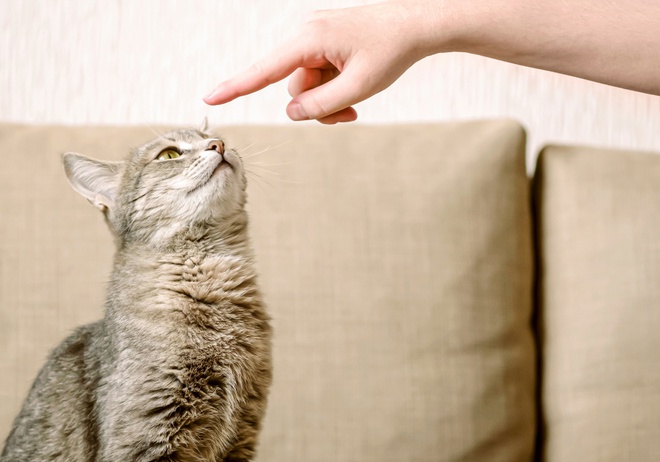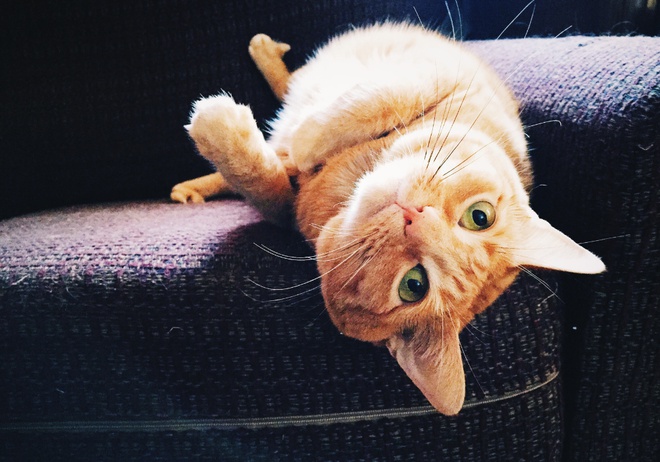Can you train a cat?
A common misconception a lot of people have is that it is impossible to train a cat. That is simply not true. If done correctly, cats are very receptive to any natural forms of training. Find out in this article how to best train your feline friend.

Reading time : 9 min
A popular belief is that you cannot train a cat. For a lot of people, cats are independent, devious, cunning, manipulative, and opportunist creatures. Based on these assumptions, cats would not be ideal for training.
But all of this comes from a misunderstanding of cats’ behaviour. You need to understand it first and keep in mind that you cannot train a cat the same way you would a dog. Cats are curious, alert, affectionate and playful, making them very receptive to training.
While kitten training can be of some benefit, it is not a requirement. So, can you train a cat? Certainly! How can you train a cat? First, you have to understand your furry friend, know their deep nature, and not want to change it at all costs.
The myth of the untrainable cat is easily dispelled if the owner is ready to understand their cat. As soon as you understand that the cat does not obey an order but follows a routine, everything becomes possible. The only prerequisite is that the cat has been properly socialised.
TOPICS
The importance of socialisation in kittens

If you have adopted your cat as a kitten or are interested in adopting a young cat, you must have heard about the infamous socialisation phase. Socialisation is the foundation of the cat's psychological balance and behaviour.
The role of the mother
The relationship between a cat and her kittens is particularly close. Kittens are born without a sense of sight and hearing. However, they have a well-developed sense of smell, and the smell of their mother is reassuring to them.
For the first 4 weeks of their lives, kittens are dependent on their mother, even though they open their eyes on day five and can see clearly by day 15. The cat is devoted to her kittens: she guides them to suckle, she licks them, she washes their coat, she warms them, she reassures them, scolds or punishes them if necessary and she makes sure that their nest is kept clean and dry.
Like with puppies, weaning represents the first signs of independence from the cat. It takes place at the end of the first month of life and will last for another month. The kitten's diet is changing, with suckling becoming less frequent in favour of solid cat food.
The role of the breeder
At the beginning, the breeder will soften the kittens' kibbles to help them go through the transition from liquids to solids. When kittens start moving, they will learn by mimicry, cleanliness, codes, and behaviours specific to the species, by observing their mother. The games between the kittens and their mother are still used for learning.
It is precisely during this time that they will learn to control their excitement, scratching and biting. This phase of mutual attachment between the cat and her kittens is essential for their proper psychological development.
During this period, the breeders are present but remain in the background as much as possible. They interact with the kittens but mainly provide for the mother’s appetite and well-being. It is only at the end of the first two months that the breeders take part in the socialisation of the kitten.
The mother feels calm in the presence of people she knows and will let the breeders handle her kittens. But any unknown situation can frighten the mother to the point of making her very aggressive.
It is the breeder's responsibility to introduce the kitten to all the different situations they will encounter in their life as an adult cat. This ranges from exposure to people and other animals to places outside the home to certain noises that the kitten is likely to encounter in the future. For example, a cat that has not been exposed to the noise of the hoover will at best hide and at worst become aggressive.
Training a cat

Unlike dogs, cats are not known for being very sociable. Cats are territorial animals that strive to live in a safe territory, where they feel good, respected, and safe.
If not, they may become anxious, very aggressive or leave to find a new, more peaceful environment. That is why it is important to establish a healthy relationship with your animal, training being one of the solutions.
Banning the Alpha dog method
The Alpha dog method of training with a cat is not an option. Aggression, shouting, or punishment have no effect on cats.
If a cat feels abused but has genuine affection for their family, they may develop anxiety, such as nibbling their claws or compulsive licking, which can damage their health.
In other cases, they may also show aggressive signs to defend themselves. In the end, they will simply run away and never come back.
How to correct a cat's behaviour
It is often best to use tricks to get your cat to be well-behaved. There are ways to divert their attention.
Buying a plant of catnip
If the cat has got into the habit of nibbling on the plants in the house, it is possible to buy a plant of catnip, which cats are particularly fond of. You can also plant it yourself. This is a very simple way to save plants but also to take care of your cat's health, as some plants can be toxic to cats.
Using a cat flap
Cats always seem indecisive when it comes to coming and going out of the house. And the meowing of a cat that wants to go out or the repeated scratching if they want to come in can quickly become unbearable.
Using a cat flap can be beneficial, especially since they have evolved a lot. It is no longer a question of seeing all the cats in the neighbourhood making themselves comfortable in your kitchen.
Some cat flaps are connected to your cat's ID chip and will only let them in. Similarly, for their safety and the peace of mind of their owners, it is possible to pre-programme exit times.
Using the smell of olives
Did you know that the smell of olives has a euphoric effect on cats? Why not use them to help you save curtains, sofas, and doors? Just buy a scratching post and rub them with an olive stone or a cloth soaked in olive juice.
Preferring the cooperative method
Cats are naturally more receptive to cooperative training and positive reinforcement due to their curious, playful, and dynamic nature. As mentioned previously, cats are more receptive to a routine rather than a command. The use of cat toys can greatly assist in training.
10 questions to test your pet training knowledge
Do you know everything there is to know about training dogs and cats? Answer our 10 questions to find out!
Tricks to teach your cat

Teach them their name
When you adopt a kitten from a breeder, there is no need to teach a kitten to use the litterbox as they will have learned it with their mother. The kitten will therefore have acquired cleanliness when they arrive in their new home.
The first trick you can teach a kitten is their name. This may take some time and is done naturally by repeating the name as often as possible.
Teach your cat recalls
Then, you can move on and teach your cat recalls. Try calling your cat by their name while shaking a bag of treats several times a day. If the cat does not respond, go to them, give them a treat, and go back to the other side of the room and do it again. As the days go by, the cat will associate the calling of their name with the giving of a treat and will come more willingly.
This learning process must not be at the expense of wearing a collar or harness, and this must be done from a very young age. Cats like to explore their surroundings.
If they have the opportunity, they will go on adventures as soon as they can. It can be beneficial to let them go out with a GPS tracker for cats to avoid the anxiety of losing a pet.
It is even possible to train your pet with a GPS collar. The GPS collar contains a recall option. Simply activate the collar's vibrator when it's time to eat.
Over time, your cat will associate the vibration of the collar with feeding time. When the collar starts to vibrate, your cat will know it is time to go home.
Train your cat to use a cat flap
First, keep the cat flap locked and start by feeding and playing with your cat nearby. Try to create positive associations with the cat flap, such as leaving treats in front of it.
Then, keep the cat flap open, with strong tape, for instance, and with a person on either side of the open cat flap, use treats or toys to entice your cat in or out.
Repeat the above several times a day for about a week. Never force your cat through the opening, especially if you feel resistance from them. As your cat becomes more familiar with the opening, you can drop the flap so that they have to push slightly to open it.
Gradually, your kitten will feel comfortable going through the cat flap. They then will be able to come and go as they please when you leave the cat flap open.
How to train a feral kitten?

It might be more complicated to train an unweaned kitten. But then how do you tame a feral kitten? An unweaned kitten is a feral kitten, as it will not have learned the codes of their species.
Acting like a mother
In addition to feeding your cat, you will have to act as much as possible as a mother would with her kitten. Always keeping them warm and holding them in your arms as often as possible is a must.
Furthermore, to acquire self-control, bites and scratches must be controlled so as not to cause pain during playtime. To teach her kittens, a mother will slap the kitten’s nose with her paw or scratch their bellies. You should not hesitate to imitate her.
Similarly, the mother stimulates the kitten’s urine and faeces by licking the belly and perineum. You should do the same with a wet cloth after each meal until the kitten is six or seven weeks old when they can learn how to clean themselves. After that, the kitten should be kept in a small room with the litter box available and regularly placed in the litter box, especially after feeding, until they’re potty trained.
The risk of hyper attachment
Unfortunately, even with all these precautions, the kitten is not exempt from developing behavioural problems as they grow up, such as hyper attachment to the person who raised them, which is characterised by hyper solicitation and anxiety when their owner is absent.
It may be worthwhile to seek advice from a cat trainer who will be able to guide the learning process to correct a behavioural problem.
Cat breeds easiest to train

All breeds of cats can be trained. Some, however, may have more distinct predispositions such as intelligence, curiosity, a taste for play or simply a special affection and attention for their owner that would make training easier. These are undeniable qualities for a successful cooperative education. Among these breeds of cats, we find:
The Abyssinian cat and the need for stimulation
The Abyssinian is known to be a very intelligent, agile, dynamic and well-balanced cat. The Abyssinian cat is very close to their owners and enjoys interacting with them. This cat breed also needs to be kept busy and enjoy being mentally stimulated through play.
The Siamese cat, a talkative and communicative cat
Siamese cat owners are unanimous: these cats are very attached to their owner and particularly like to be the centre of attention. They are active and curious and like to play as long as their owner is involved. It is said that the Siamese cat is a “dog cat”. This means that natural training should not be a problem for Siamese owners.
The Bengal cat, a very intelligent cat
The Bengal is a particularly intelligent cat that is attentive to their surroundings. They can be active and playful as well as gentle and affectionate. Cooperative training should be quite exciting for this cat who likes to be stroked and praised.
The Burmese cat, thriving off of positive reinforcement
The Burmese cat is always looking for recognition and will strongly appreciate the rewards and petting that come with natural training. But this cat is also curious, intelligent, docile and loves it when their owner takes the time to play with them.
The Cornish Rex cat, a born player
The Cornish Rex is a very athletic cat, but above all, a tireless player. They love to spend time with their owners, so much so that some of them seem to enjoy walking around on a lead.
The Savannah cat, a sociable cat
With their wild appearance reminiscent of the cheetah, the Savannah is a very sociable cat that easily gets attached to their family. Naturally spirited, active, enthusiastic, and extremely playful, they have a great need to exercise with praise and rewards.
The Scottish Fold cat, an affectionate cat
The Scottish Fold is very curious and likes to be stimulated during play sessions. They enjoy their owner's company, affection, and petting.
Conclusion
Training a cat is not as easy as training a dog, but it is doable. However, it is possible to train a cat if you are lenient and respect the cat's nature. That said, the cat's education takes over from socialisation, which must necessarily be successful. If coercive training does not produce the desired results, the natural method and conditioning are truly effective.
Finally, some breeds of cat seem to have mental aptitudes, a strong taste for play or curiosity that predispose them to cat training, but in reality, all cats are receptive to cat training as long as their owners are gentle and show patience.
Continue reading our guide
This article is a part of a complete guide on the subject. Do not miss the next chapters.
Do you know everything there is to know about training pets?
Answer our 10 questions to test your pet training knowledge.


